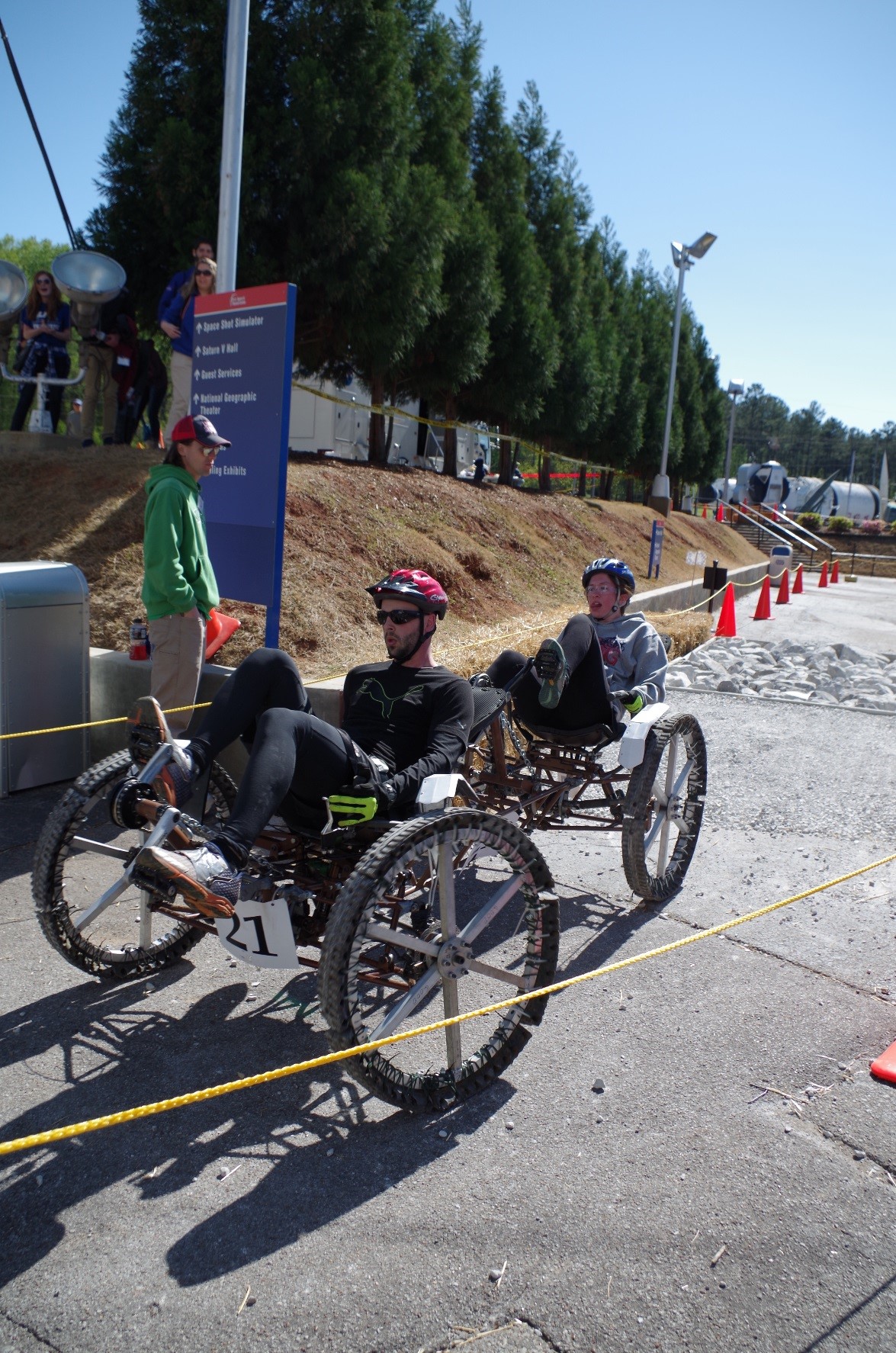
Sam Oltman, a senior in mechanical engineering from of Putnam, front, and Olivia Taitt, a sophomore in mechanical engineering from Lebanon, fly through the course during NASA’s Human Exploration Rover Challenge, held April 8-9 in Huntsville, Ala. (Photo provided)
April 20, 2016
SIU teams finish in top 10 in NASA competition
CARBONDALE, Ill. – Two teams from Southern Illinois University Carbondale finished in the top 10 during this year’s Human Exploration Rover Challenge, held April 8-9 in Huntsville, Ala.
The annual contest is sponsored by NASA. Previously known as the “moonbuggy race” and hosted by NASA’s Marshall Space Flight Center, the SIU teams finished eighth and ninth overall in this year’s competition. The SIU teams also were finalists in the wheel design competition, said Tsuchin Chu, professor of mechanical engineering and energy processes, and faculty adviser for the teams.
“Both teams did very well,” Chu said. “I am proud of their resourcefulness during the race and their overall accomplishment.”
The event featured almost 70 teams of high school, college and university students from 18 states and Puerto Rico, as well as a strong contingent of international teams from Germany, India, Mexico, Italy, and Russia. Rafaelina E. Lebron Flores of Patillas, Puerto Rico, won first place in the high school division, while a team from Purdue University won the college division.
Jess Pille, a senior in mechanical engineering and president of the club, said SIU bested teams from other top universities, including Arizona State, Ohio State, as well as universities from Germany and Russia.
“We were also top contenders in the tire design with several NASA and Boeing official judges interested in our work,” said Pille, of Hanna City. “The whole team was very motivated to compete this year and everyone had a helping hand in the construction of this year’s buggy.”
The competition is designed as a research project for students to investigate and test technologies that could potentially be used on future deep-space exploration missions. NASA made two new and important changes to the event this year, one of those being a requirement that teams design and fabricate their own wheels. Any component used to contact the course surface for traction and mobility had to be original and not an “off-the-shelf” or commercially available item.
Second, NASA created an optional “sample retrieval challenge” in which teams teams attempted to use a mechanical arm or grabber designed and built by the team to collect samples of four different substances – liquid, small pebbles, large rocks and soil – in the fastest time.
SIU both built a new buggy and brought an older one out of “retirement” for this year’s competition. Pille said both SIU buggies experienced problems with steering, which was a major contributor to some of the penalties the teams incurred.
“But we persevered and managed to get both buggies to run for a great finish,” he said.
A veteran of four such competitions, the “silver buggy” had won the best design award in 2013 and earned a second-place finish in 2014. The SIU team assigned to it won eighth place with a time of 9 minutes 56 seconds.
“It ran both days and was the last buggy on Friday to run, as well as one of the first to run on Saturday,” Pille said.
The team assembled the 216-pound buggy – part of the competition requirements – in just 10 seconds. The buggy ran the course in 7:35 on Friday, but was assessed three, one-minute penalties. On Saturday, it ran the course in 6:46, again with three, one-minute penalties. Michaela Lydon, from Houston, and Roger Mast, from Arthur, both juniors in mechanical engineering, were the primary drivers on the silver buggy.
The silver buggy also participated in the sample retrieval challenge. The riders for this mission were Liz Popolizio, of Ridgecrest, Calif., and Jacob Churchill of Petersburg, both juniors in mechanical engineering. Both were first-timers at the event.
This year’s new buggy, the “bronze buggy,” was designed by the 2016 senior design team. That team included Pille, Jacob Pacotti of Mackinaw, Lucas Fink of Dwight, and Sam Oltman of Putnam, who served as project manager. All are seniors in mechanical engineering.
The bronze buggy, which finished ninth overall with a time of 11:08 – including four one-minute penalties – only managed to race on Saturday. Oltman, a veteran of three previous contests, and Olivia Taitt, a sophomore in mechanical engineering from Lebanon, rode the 204-pound machine.
“The bronze buggy weighed 12 pounds less than the silver buggy and ran a 22-second faster time,” Pille said. “Unfortunately we had failures in steering, ergonomics and drive, which many of these issues could have been resolved given more time to test.
“Regardless, the members of the club who will be leading the team next year say that they would like to improve the bronze buggy, and potentially retire the silver buggy,” he said.
Other members of this year’s SIU team included Michael Kiesewetter, a junior from Farmington;
Marquise Rodgers, a senior from Bellwood; Evan Butler, a sophomore from Mundelein; Evan Gebhardt, a junior from Carol Stream; Austin Peterson, a senior from Rockford; and Ifreke Umana, a graduate student from Carbondale. All are mechanical engineering majors.
